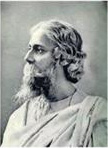
Indian National Anthem
The Indian National anthem, composed originally in Bengali by Rabindranath Tagore, was adopted in its Hindi version by the Constituent Assembly as the National Anthem of India on 24 January 1950. It was first sung 27 December 1911 at the Calcutta session of the Indian National Congress. The complete song consists of five stanzas. The lyrics were rendered into English by Tagore himself.
Rabindranath Tagore (1861-1941) was the youngest son of Debendranath Tagore, a leader of the Brahmo Samaj, which was a new religious sect in nineteenth-century Bengal and which attempted a revival of the ultimate monistic basis of Hinduism.
Whenever the Anthem is sung or played, the audience shall stand to attention. However, when in the course of a newsreel or documentary the Anthem is played as a part of the film, it is not expected of the audience to stand as standing is bound to interrupt the exhibition of the film and would create disorder and confusion rather than add to the dignity of the Anthem. As in the case of the flying of the National Flag, it has been left to the good sense of the people not to indulge in indiscriminate singing or playing of the Anthem.
Anthem Text
" Jana Gana Mana Adhinayaka Jaya He Bharat Bhagya Vidhata Punjab Sindh Gujarat Maratha Dravida Utkala Banga Vindhya Himachal Yamuna Ganga Ucchala Jaladhi Taranga Tubh Shubha Name Jage Tubh Shubha Ashisha Mange Gahe Tubh Jaya Gata Jan Gan Mangaldayak Jay He Bharat Bhagya Vidhata Jaye He ! Jaye He ! Jaye He ! Jaye,Jaye,Jaye,Jaye He "
Translation in Jana Gana Mana In English
Thou are the ruler of the minds of all people, dispenser of India's destiny.
The name rouses the hearts of Punjab, Sind, Gujurat and Maratha. Of the Dravid and Orissa and Bengal.
It Echoes in the hills of Vindhyas and Himalayas, mingles in the music of Yamuna and Ganga and is chanted by the waves of the Indian Sea.
They pray for your blessing and sing thy praise. The salvation of all peaople is thy hand, thou dispenser of India's destiny. Victory, Victory, Victory to thee.
Play Indian National Anthem